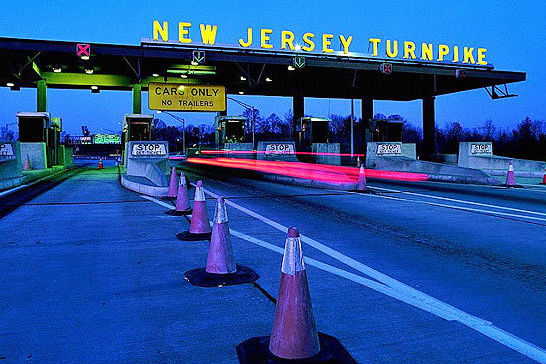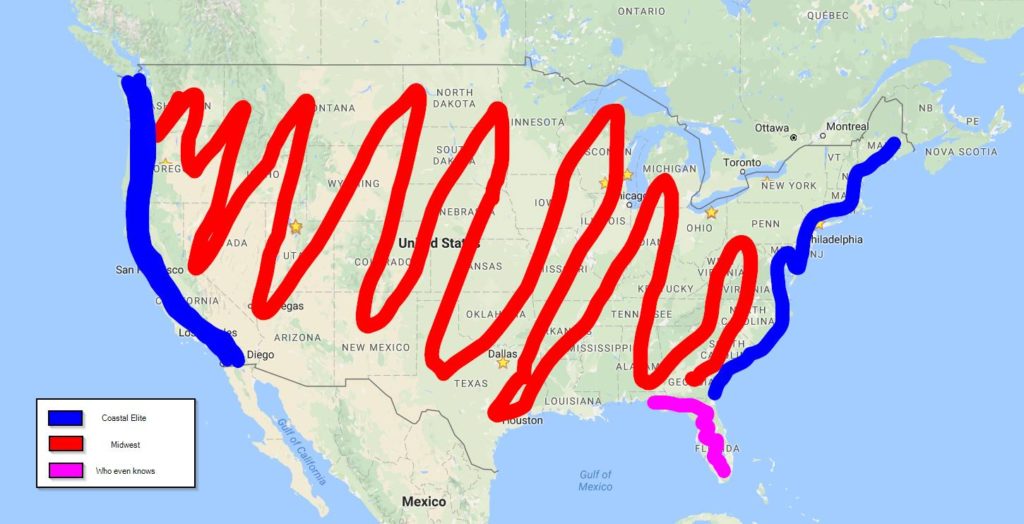
It is human priorities that should be driving Smart City initiatives, like the ones in Toronto profiled here last week.
Last week’s post also focused on a pioneering spirit in Toronto that many American cities and towns seem to have lost. While we entrench in the moral righteousness of our sides in the debate—including, for many, a distrust of collective governance, regulation and taxation—we drift towards an uncertain future instead of claiming one that can be built on values we actually share.
In its King Street and Quayside initiatives, Toronto is actively experimenting with the future it wants based on its residents’ commitment to sustaining their natural environment in the face of urban life’s often toxic impacts. They’re conducting these experiments in a relatively civil, collaborative and productive way—an urban role model for places that seem to have forgotten how to work together. Toronto’s bold experiments are also utilizing “smart” technologies in their on-going attempts to “optimize” living and working in new, experimental communities.
During a short trip this week, I got to see the leading edges of New York City’s new Hudson Yards community (spread over 28 acres with an estimated $25 billion price tag) and couldn’t help being struck by how much it catered to those seeking more luxury living, shopping and workspaces than Manhattan already affords. In other words, how much it could have been a bold experiment about new ways that all of its citizens might live and work in America’s first city for the next half-century, but how little it actually was. A hundred years ago, one of the largest immigrant migrations in history made New York City the envy of the world. With half of its current citizens being foreign-born, perhaps the next century, unfurling today, belongs to newer cities like Toronto.
Still, even with its laudable ambition, it will not be easy for Toronto and other future-facing communities to get their Smart City initiatives right, as several of you were also quick to remind me last week. Here is a complaint from a King Street merchant that one of you (thanks Josh!) found and forwarded that seems to cast what is happening in Toronto in a less favorable light than I had focused upon it:
What a wonderful story. But as with [all of] these wonderful plans some seem to be forgotten. As it appears are the actual merchants. Google certainly a big winner here. Below an excerpt written by one of the merchants:
‘The City of Toronto has chosen the worst time, in the worst way, in the worst season to implement the pilot project. Their goal is clearly to move people through King St., not to King St. For years King St. was a destination, now it is a thoroughfare.
‘The goal of the King St. Pilot project was said to be to balance three important principles: to move people more effectively on transit, to support business and economic prosperity and to improve public space. In its current form, the competing principles seem to be decidedly tilted away from the economic well-being of merchants and biases efficiency over convenience. The casual stickiness of pedestrians walking and stopping at stores, restaurants and other merchants is lost.
‘Additionally, the [transit authority] TTC has eliminated a number of stops along King St., forcing passengers to walk further to enter and disembark streetcars, further reducing pedestrian traffic and affecting areas businesses. The TTC appears to believe that if they didn’t have to pick up and drop off people, they could run their system more effectively.
‘The dubious benefits of faster street car traffic on King St. notwithstanding, the collateral damage of the increased traffic of the more than 20,000 cars the TTC alleges are displaced from King St to adjoining streets has turned Adelaide, Queen, Wellington and Front Sts. into a gridlock standstill. Anyone who has tried to navigate the area can attest that much of the time, no matter how close you are you can’t get there from here.
‘Along with the other merchants of King St. and the Toronto Entertainment District we ask that Mayor Tory and Toronto council to consider a simple, reasonable and cost-effective alternative. Put lights on King St. that restrict vehicle traffic during rush hours, but return King St. to its former vibrant self after 7 p.m., on weekends and statutory holidays. It’s smart, fair, reasonable and helps meet the goals of the King St. pilot project.
Two things about this complaint seemed noteworthy. The first is how civil and constructive this criticism is in a process that hopes to “iterate” as real time impacts are assessed. It’s a tribute that Toronto’s experiments not only invite but are also receiving feedback like this. Alas, the second take-away from Josh’s comment is far more nettlesome. “[However many losers there may be along the way:] Google certainly a big winner here.”
The tech giant’s partnership with Canada’s governments in Toronto raises a constellation of challenging issues, but it’s useful to recall that pioneers who dare to claim new frontiers always do so with the best technology that’s available. While the settling of the American West involved significant collateral damage (to Native Americans and Chinese migrants, to the buffalo and the land itself), it would not have been possible without existing innovations and new ones that these pioneers fashioned along the way. Think of the railroads, the telegraph poles, even something as low-tech as the barbed wire that was used to contain livestock.
The problem isn’t human and corporate greed or heartless technology—we know about them already—but failing to recognize and reduce their harmful impacts before it is too late. The objective for pioneers on new frontiers should always be maximizing the benefits while minimizing the harms that can be foreseen from the very beginning instead of looking back with anger after the damage is done.
We have that opportunity with Smart City initiatives today.
Because they concentrate many of the choices that will have to be made when we boldly dare to claim the future of America again, I’ve been looking for a roadmap through the moral thicket in the books and articles that are being written about these initiatives today. Here are some of the markers that I’ve discovered.

1. Markers on the Road to Smarter and More Vibrant Communities
The following insights come almost entirely from a short article by Robert Kitchin, a professor at Maynooth University in Ireland. In my review of the on-going conversation about Smart Cities, I found him to be one of its most helpful observers.
In his article, Kitchin discusses the three principal ways that smart cities are understood, the key promises smart initiatives make to stakeholders, and the perils to be avoided around these promises.
Perhaps not surprisingly, people envision cities and other communities “getting smarter” in different ways. One constituency sees an opportunity to improve both “urban regulation and governance through instrumentation and data-driven systems”–essentially, a management tool. A bolder and more transformative vision sees information and communication technology “re-configur[ing] human capital, creativity, innovation, education, sustainability, and management,” thereby “produc[ing] smarter citizens, workers and public servants” who “can enact polic[ies], produce better products… foster indigenous entrepreneurship and attract inward investment.” The first makes the frontier operate more efficiently while the second improves nearly every corner of it.
The third Smart City vision is “a counter-weight or alternative” to each of them. It wants these technologies “to promote a citizen-centric model of development that fosters social innovation and social justice, civic engagement and hactivism, and transparent and accountable governance.” In this model, technology serves social objectives like greater equality and fairness. Kitchin reminds us that these three visions are not mutually exclusive. It seems to me that the priorities embedded in a community’s vision of a “smarter” future could include elements of each of them, functioning like checks and balances, in tension with one another.
Smart City initiatives promise to solve pressing urban problems, including poor economic performance; government dysfunction; constrained mobility; environmental degradation; a declining quality of life, including risks to safety and security; and a disengaged, unproductive citizen base. Writes Kitchin:
the smart city promises to solve a fundamental conundrum of cities – how to reduce costs and create economic growth and resilience at the same time as producing sustainability and improving services, participation and quality of life – and to do so in commonsensical, pragmatic, neutral and apolitical ways.
Once again, it’s a delicate balancing act with a range of countervailing interests and constituencies, as you can see in the chart from a related discussion above.
The perils of Smart Cities should never overwhelm their promise in my view, but urban pioneers should always have them in mind (from planning through implementation) because some perils only manifest themselves over time. According to Kitchin, the seven dangers in pursuing these initiatives include:
–taking “a ‘one size fits all’ approach, treating cities as generic markets and solutions [that are] straightforwardly scalable and movable”;
–assuming that initiatives are “objective and non-ideological, grounded in either science or commonsense.” You can aim for these ideals, but human and organizational preferences and biases will always be embedded within them.
–believing that the complex social problems in communities can be reduced to “neatly defined technical problems” that smart technology can also solve. The ways that citizens have always framed and resolved their community problems cannot be automated so easily. (This is also the thrust of Ben Green’s Smart Enough City: Putting Technology in Its Place to Reclaim Our Urban Future, which will be published by MIT Press in April. In it he argues for “smart enough alternatives” that are attainable with the help of technology but never reducible to technology solutions alone.)
–engaging with corporations that are using smart city technologies “to capture government functions as new market opportunities.” One risk of a company like Google to communities like Toronto’s is that Google might lock Toronto in to its proprietary technologies and vendors over a long period of time or use Toronto’s citizen data to gain business opportunities in other cities.
–becoming straddled with “buggy, brittle and hackable” systems that are ever more “complicated, interconnected and dependent on software” while becoming more resistant to manual fixes.
–becoming victimized by “pervasive dataveillance that erodes privacy” through practices like “algorithmic social sorting (whether people get a loan, a tenancy, a job, etc), dynamic pricing (whereby different people pay varying prices depending on their perceived customer value) and anticipatory governance using predictive profiling (wherein data precedes how a person is policed and governed).” Earlier this month, my post on popular on-line games like Fortnite highlighted the additional risk that invasive technologies can use the data they are gathering to change peoples’ behavior.
-and lastly, reinforcing existing power structures and inequalities instead of eroding or reconfiguring them.
While acknowledging the promise of Smart Cities at their best, Kitchin closes his article with this cautionary note:
the realities of implementation are messier and more complex than the marketing hype of corporations or city managers portray and there are a number of social, political, ethical and legal concerns with respect to the kind of society smart city initiatives seek to create. As such, whilst networked urbanism has benefits, it also poses challenges and risks that are often little explored or legislated for ahead of implementation. Indeed, the pace of development and rollout of smart city technologies is proceeding well ahead of wider reflection, critique and regulation.
Putting the cart before a suitably-designed horse is a problem with all new and seductive technologies that get embraced before their harms are identified or can be addressed—a quandary that was also considered here in a post called “Looking Out for the Human Side of Technology.”

2. The Value of Our Data
A few additional considerations about the Smart City are also worth bearing in mind as debate about these initiatives intensifies.
In a March 8, 2019 post, Kurtis McBride wrote about two different ways “to value” the data that these initiatives will produce, and his distinction is an important one. It’s a discussion that citizens, government officials and tech companies should be having, but unfortunately are not having as much as they need to.
When Smart City data is free to everyone, there is the risk that the multinationals generating it will merely use it to increase their power and profits in the growing market for Smart City technologies and services. From the residents’ perspective, McBride argues that it’s “reasonable for citizens to expect to see benefit” from their data, while noting that these same citizens will also be paying dearly for smart upgrades to their communities. His proposal on valuing citizen data depends on how it will be used by tech companies like Google or local service providers. For example, if citizen data is used:
to map the safest and fastest routes for cyclists across the city and offers that information free to all citizens, [the tech company] is providing citizen benefit and should be able to access the needed smart city data free of charge.
But, if a courier company uses real-time traffic data to optimize their routes, improving their productivity and profit margins – there is no broad citizen benefit. In those cases, I think it’s fair to ask those organizations to pay to access the needed city data, providing a revenue stream cities can then use to improve city services for all.
Applying McBride’s reasoning, an impartial body in a city like Toronto would need to decide whether Google has to pay for data generated in its Quayside community by consulting a benefit-to-citizens standard. Clearly, if Google wanted to use Quayside data in a Smart City initiative in say Colorado or California, it would need to pay Toronto for the use of its citizens’ information.
Of course, addressing the imbalance between those (like us) who provide the data and the tech companies that use it to increase their profits and influence is not just a problem for Smart City initiatives, and changing the “value proposition” around our data is surely part of the solution. In her new book Age of Surveillance Capitalism: the Fight for a Human Future in the New Frontier of Power, Harvard Business School’s Shoshana Zuboff says that “you’re the product if these companies aren’t paying you for your data” does not state the case powerfully enough. She argues that the big tech platforms are like elephant poachers and our personal data like those elephants’ ivory tusks. “You are not the product,” she writes. “You are the abandoned carcass.”
Smart City initiatives also provide a way to think about “the value of our data” in the context of our living and working and not merely as the gateway to more convenient shopping, more addictive gaming experiences or “free” search engines like Googles’.
This post is adapted from my March 24, 2019 newsletter. Subscribe today and receive an email copy of future posts in your inbox each week.





